In the ever-evolving landscape of compact cars, the Hyundai i10 and Mazda 2 stand out as popular options for urban drivers who prioritize efficiency and style. This comparison delves into the technical aspects, innovations, and overall driving experience that each vehicle offers.
Hyundai i10 vs Mazda 2 – Which car suits you better?
Two cars, one duel: Hyundai i10 meets Mazda 2.
Which one wins in performance, efficiency and value for money? Find out now!
Design and Dimensions
The Hyundai i10 presents a fresh and dynamic design characterized by its sporty hatchback silhouette. Measuring 3,670 mm in length and 1,680 mm in width, it offers a compact form that is ideal for city driving. In contrast, the Mazda 2 is slightly larger at 4,080 mm long and 1,695 mm wide, providing more interior room while retaining a sleek appearance.
Height-wise, the i10 stands at 1,480 mm (1,483 mm for certain variants), while the Mazda 2 is taller at 1,515 mm. Both vehicles feature five doors for easy access, making them practical choices for daily commutes or weekend adventures.
Performance and Engine Options
The Hyundai i10 offers a variety of petrol engines with power outputs ranging from 63 HP to 90 HP, featuring a choice between manual and automated manual transmissions. With a top speed of up to 175 km/h and acceleration times from 11.4 seconds to 18.4 seconds for 0-100 km/h, the i10 balances efficiency and performance well, especially for city conditions.
On the other hand, the Mazda 2 excels with its 1.5-liter petrol engine, delivering up to 115 HP. Acceleration is brisk, clocking in at just 9.1 seconds for the 0-100 km/h mark. With a maximum speed of 200 km/h, the Mazda 2 aims to provide a spirited driving experience that can handle both urban streets and open roads.
Fuel Efficiency and Emissions
Fuel economy is a critical aspect of any urban vehicle, and the Hyundai i10 boasts consumption figures ranging from 4.9 to 5.4 L/100 km. With CO2 emissions between 111 and 123 g/km, it ranks well for environmental efficiency in its class.
The Mazda 2, with its slightly larger engine, manages to maintain competitive fuel efficiency, averaging between 4.7 and 5.4 L/100 km. Its CO2 emissions range from 107 to 113 g/km, making it a strong contender in terms of eco-friendliness without sacrificing driving excitement.
Interior and Technology
Stepping inside, the Hyundai i10 offers a user-friendly dashboard with ample technology, featuring a touchscreen infotainment system that supports smartphone connectivity. Despite its smaller size, it provides comfortable seating for up to five passengers and a trunk capacity of 252 liters.
The Mazda 2, with its emphasis on quality and driver experience, features a premium interior design. The layout is intuitive, offering an infotainment system that integrates seamlessly with your devices. With a slightly larger trunk capacity of 280 liters, it gives users extra room for groceries or luggage while comfortably seating five passengers.
Safety Features and Innovations
Both models prioritize safety, featuring multiple airbags and advanced braking systems. The i10 comes equipped with Hyundai's SmartSense technologies, including lane-keeping assist and enhanced rear-view sensors. The Mazda 2, on the other hand, incorporates i-Activsense safety technologies, such as adaptive cruise control and a high-strength body structure that enhances crash protection.
Conclusion
In conclusion, the choice between the Hyundai i10 and Mazda 2 ultimately depends on individual preferences regarding performance, style, and technological needs. The i10 is perfect for those seeking a compact, economical car for city driving, while the Mazda 2 appeals to those desiring a blend of performance and luxury in a larger hatchback. Both vehicles deliver on the promise of modern automotive innovation, making them worthy contenders in the compact car segment.
Here’s where it gets real: The technical differences in detail
Costs and Efficiency:
Price and efficiency are key factors when choosing a car – and this is often where the real differences emerge.
Mazda 2 has a minimal advantage in terms of price – it starts at 14200 £, while the Hyundai i10 costs 14600 £. That’s a price difference of around 342 £.
Fuel consumption also shows a difference: Mazda 2 manages with 4.70 L and is therefore minimal more efficient than the Hyundai i10 with 4.90 L. The difference is about 0.20 L per 100 km.
Engine and Performance:
Power, torque and acceleration are the classic benchmarks for car enthusiasts – and here, some clear differences start to show.
When it comes to engine power, the Mazda 2 has a distinct edge – offering 115 HP compared to 90 HP. That’s roughly 25 HP more horsepower.
In acceleration from 0 to 100 km/h, the Mazda 2 is distinct quicker – completing the sprint in 9.10 s, while the Hyundai i10 takes 11.40 s. That’s about 2.30 s faster.
In terms of top speed, the Mazda 2 performs slightly better – reaching 200 km/h, while the Hyundai i10 tops out at 175 km/h. The difference is around 25 km/h.
There’s also a difference in torque: Hyundai i10 pulls slightly stronger with 172 Nm compared to 151 Nm. That’s about 21 Nm difference.
Space and Everyday Use:
Cabin size, boot volume and payload all play a role in everyday practicality. Here, comfort and flexibility make the difference.
Both vehicles offer seating for 5 people.
In curb weight, Hyundai i10 is slightly lighter – 996 kg compared to 1099 kg. The difference is around 103 kg.
In terms of boot space, the Mazda 2 offers barely noticeable more room – 280 L compared to 252 L. That’s a difference of about 28 L.
In maximum load capacity, the Hyundai i10 performs hardly perceptible better – up to 1050 L, which is about 100 L more than the Mazda 2.
When it comes to payload, Mazda 2 minimal takes the win – 437 kg compared to 423 kg. That’s a difference of about 14 kg.
Who comes out on top?
Overall, the Mazda 2 shows itself to be is largely superior and secures the title of DriveDuel Champion.
It convinces with the more balanced overall package and proves to be the more versatile choice for everyday use.
 @ Mazda Motor Corporation
@ Mazda Motor Corporation
Mazda 2
Hyundai i10
The Hyundai i10 is a cheeky city car that squeezes big-car confidence into a pocket-friendly package, carving through tight streets with surprising composure and sensible practicality. For buyers after low fuss, sensible equipment and wallet-friendly running costs, it's a smart, no-nonsense pick that makes sense whether you're a first-time driver or need a reliable second car.
details @ Hyundai Motor Company
@ Hyundai Motor Company
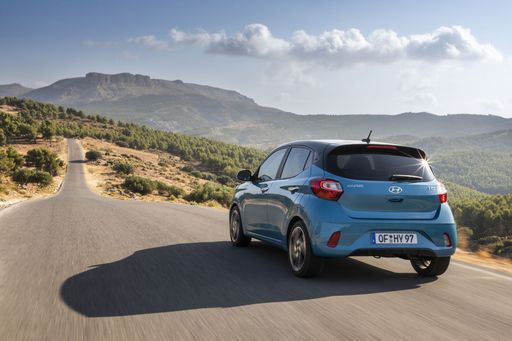 @ Hyundai Motor Company
@ Hyundai Motor Company
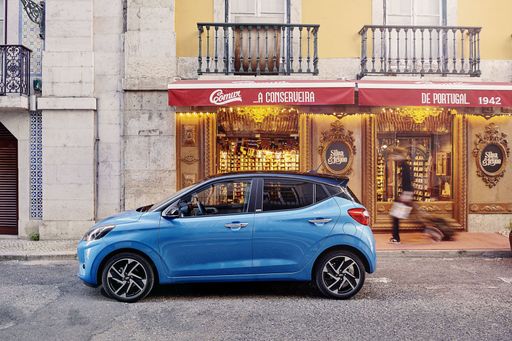 @ Hyundai Motor Company
@ Hyundai Motor Company
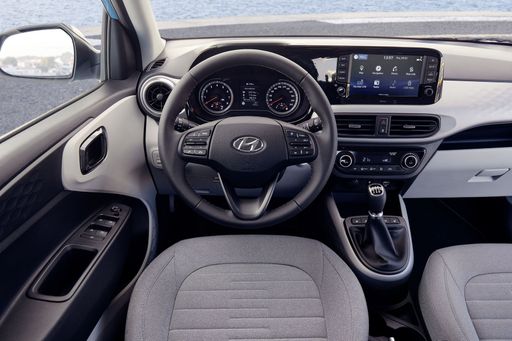 @ Hyundai Motor Company
@ Hyundai Motor Company
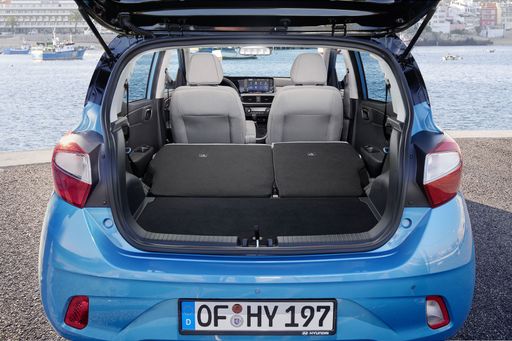 @ Hyundai Motor Company
@ Hyundai Motor Company
Mazda 2
Toyota's compact and efficient Yaris has made quite a buzz in the automotive world with its sleek design and impressive fuel economy. Known for its reliability and affordability, the Yaris is a popular choice among city dwellers and young drivers who seek a practical yet stylish ride. Inside, the Yaris offers a surprisingly spacious interior with modern technology that caters to the everyday needs of its passengers.
details @ Mazda Motor Corporation
@ Mazda Motor Corporation
 @ Mazda Motor Corporation
@ Mazda Motor Corporation
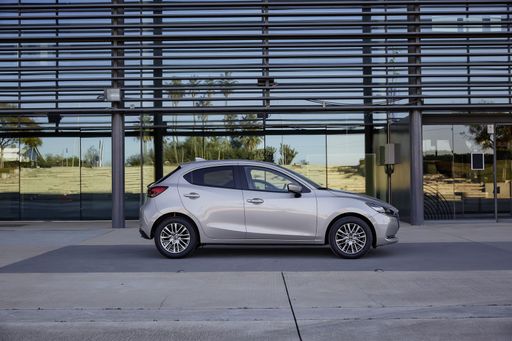 @ Mazda Motor Corporation
@ Mazda Motor Corporation
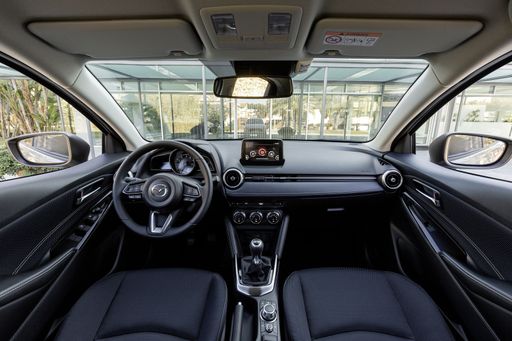 @ Mazda Motor Corporation
@ Mazda Motor Corporation
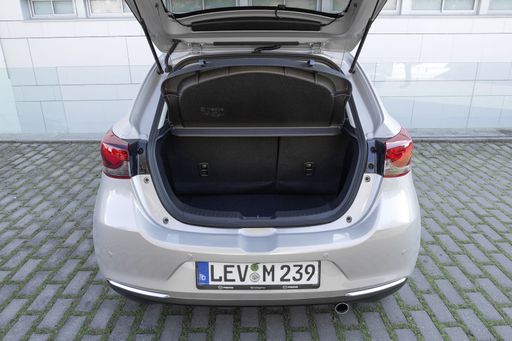 @ Mazda Motor Corporation
@ Mazda Motor Corporation
 @ Hyundai Motor Company
@ Hyundai Motor Company
|
 @ Mazda Motor Corporation
@ Mazda Motor Corporation
|
|
|
|
Costs and Consumption |
|
|---|---|
|
Price
14600 - 19000 £
|
Price
14200 - 21700 £
|
|
Consumption L/100km
4.9 - 5.5 L
|
Consumption L/100km
4.7 - 5.4 L
|
|
Consumption kWh/100km
-
|
Consumption kWh/100km
-
|
|
Electric Range
-
|
Electric Range
-
|
|
Battery Capacity
-
|
Battery Capacity
-
|
|
co2
110 - 124 g/km
|
co2
107 - 122 g/km
|
|
Fuel tank capacity
36 L
|
Fuel tank capacity
44 L
|
Dimensions and Body |
|
|---|---|
|
Body Type
Hatchback
|
Body Type
Hatchback
|
|
Seats
4 - 5
|
Seats
5
|
|
Doors
5
|
Doors
5
|
|
Curb weight
996 - 1099 kg
|
Curb weight
1099 - 1120 kg
|
|
Trunk capacity
252 L
|
Trunk capacity
280 L
|
|
Length
3670 - 3675 mm
|
Length
4080 mm
|
|
Width
1680 mm
|
Width
1695 mm
|
|
Height
1480 - 1483 mm
|
Height
1515 mm
|
|
Max trunk capacity
1050 L
|
Max trunk capacity
950 L
|
|
Payload
344 - 423 kg
|
Payload
420 - 437 kg
|
Engine and Performance |
|
|---|---|
|
Engine Type
Petrol
|
Engine Type
Petrol MHEV, Petrol
|
|
Transmission
Manuel, Automatic
|
Transmission
Manuel, Automatic
|
|
Transmission Detail
Manual Gearbox, Automated Manual
|
Transmission Detail
Manual Gearbox, Automatic Gearbox
|
|
Drive Type
Front-Wheel Drive
|
Drive Type
Front-Wheel Drive
|
|
Power HP
63 - 90 HP
|
Power HP
75 - 115 HP
|
|
Acceleration 0-100km/h
11.4 - 18.4 s
|
Acceleration 0-100km/h
9.1 - 12.1 s
|
|
Max Speed
143 - 175 km/h
|
Max Speed
171 - 200 km/h
|
|
Torque
93 - 172 Nm
|
Torque
143 - 151 Nm
|
|
Number of Cylinders
3 - 4
|
Number of Cylinders
4
|
|
Power kW
46 - 66 kW
|
Power kW
55 - 85 kW
|
|
Engine capacity
998 - 1197 cm3
|
Engine capacity
1496 cm3
|
General |
|
|---|---|
|
Model Year
2024
|
Model Year
2023
|
|
CO2 Efficiency Class
C, D
|
CO2 Efficiency Class
C, D
|
|
Brand
Hyundai
|
Brand
Mazda
|
Is the Hyundai i10 offered with different drivetrains?
The Hyundai i10 is offered with Front-Wheel Drive.
The prices and data displayed are estimates based on German list prices and may vary by country. This information is not legally binding.
